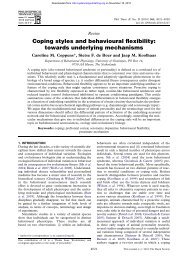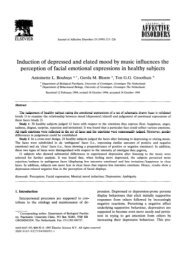Colin Pittendrigh, Jürgen Aschoff, and the Natural Entrainment - CBN
Colin Pittendrigh, Jürgen Aschoff, and the Natural Entrainment - CBN
Colin Pittendrigh, Jürgen Aschoff, and the Natural Entrainment - CBN
Create successful ePaper yourself
Turn your PDF publications into a flip-book with our unique Google optimized e-Paper software.
198 JOURNAL OF BIOLOGICAL RHYTHMS / June 2000<br />
Figure 4. <strong>Jürgen</strong> <strong>Aschoff</strong> <strong>and</strong> <strong>Colin</strong> <strong>Pittendrigh</strong> in front of <strong>the</strong><br />
blackboard in <strong>the</strong> library of <strong>the</strong> Max Planck Institut für<br />
Verhaltensphysiologie in Erling-Andechs (photograph in<br />
<strong>Aschoff</strong>’s estate).<br />
effect of one transition, (b) <strong>the</strong> difference of <strong>the</strong> effects<br />
of two transitions, (c) by <strong>the</strong> net (integrated) effects of<br />
continuous actions, or (d) by some combination of<br />
<strong>the</strong>se possibilities. It seems probable that in <strong>the</strong> majority<br />
of organisms <strong>the</strong> fourth possibility is realized.<br />
(<strong>Aschoff</strong>, 1963 p. 591)<br />
<strong>Pittendrigh</strong> later thought of ways to derive predictions<br />
on τ as a function of light intensity from <strong>the</strong> PRC.<br />
This led to <strong>the</strong> proposition of velocity response curves,<br />
with continuous light accelerating <strong>and</strong> decelerating<br />
<strong>the</strong> oscillation in different phases (Daan <strong>and</strong><br />
<strong>Pittendrigh</strong>, 1976).<br />
In <strong>the</strong>ir private lives, <strong>Aschoff</strong> <strong>and</strong> <strong>Pittendrigh</strong> (Fig. 4)<br />
became very close friends, <strong>and</strong> this friendship<br />
included <strong>the</strong> families. They had met in 1958, when<br />
<strong>Aschoff</strong> made his first trip to <strong>the</strong> United States. From<br />
this visit, <strong>the</strong> idea of <strong>the</strong> Cold Spring Harbor Symposium<br />
of 1960 was born, as well as a lifelong intense<br />
exchange of ideas, letters, <strong>and</strong> sympathy. <strong>Aschoff</strong> once<br />
noted <strong>the</strong> ups <strong>and</strong> downs in <strong>Pittendrigh</strong>’s productivity,<br />
<strong>and</strong> at Pitt’s retirement symposium on Mount<br />
Hood, Oregon, in 1984, he claimed to have established<br />
a multiannual cycle in scientific performance, which<br />
<strong>the</strong>n led him to analyze his own production <strong>and</strong> compare<br />
<strong>the</strong>ir results (Fig. 5). <strong>Aschoff</strong>’s conclusion from<br />
<strong>the</strong> analysis was, “always in harmony, never in<br />
synchrony.”<br />
Success <strong>and</strong> Problems of <strong>the</strong> PRC model<br />
The nonparametric PRC model has become st<strong>and</strong>ard<br />
textbook stuff, while few of <strong>the</strong> present genera-<br />
Downloaded from<br />
http://jbr.sagepub.com at University of Groningen on July 31, 2009<br />
tion have heard about <strong>Aschoff</strong>’s level-<strong>and</strong>-threshold<br />
<strong>the</strong>ory. Perhaps <strong>the</strong> greatest success of <strong>the</strong> PRC<br />
entrainment model was <strong>the</strong> PRC itself. It gave <strong>the</strong> field<br />
its first-rate, clearly defined, experimental tool for<br />
probing <strong>the</strong> physiology of circadian systems.<br />
As far as entrainment is concerned, <strong>the</strong> PRC model<br />
yielded highly accurate predictions for <strong>the</strong> pattern of<br />
entrainment of Drosophila eclosion rhythms by brief<br />
light pulses. The range of entrainment by different<br />
Zeitgeber periods could be predicted, <strong>and</strong> so could <strong>the</strong><br />
phase of both <strong>the</strong> overt rhythm <strong>and</strong> <strong>the</strong> underlying<br />
oscillator. The match between prediction <strong>and</strong> observation<br />
culminated when <strong>Pittendrigh</strong> used skeleton<br />
photoperiods <strong>and</strong> was able to precisely predict <strong>the</strong><br />
so-called zone of bistability <strong>and</strong> where <strong>the</strong> oscillator<br />
would l<strong>and</strong> depending on initial conditions<br />
(<strong>Pittendrigh</strong>, 1981b).<br />
When I was at Stanford in <strong>the</strong> early 1970s, we<br />
started to look for similar matches in nocturnal mammals.<br />
Indeed, <strong>the</strong>re was reasonable agreement<br />
between predicted <strong>and</strong> observed phase in a skeleton<br />
photoperiod, for instance, in <strong>the</strong> white-footed<br />
deermouse (Fig. 6). The lines on <strong>the</strong> left side indicate<br />
predicted onsets of activity, as dependent on skeleton<br />
photoperiod duration <strong>and</strong> on individual τ. The circles<br />
are <strong>the</strong> individual observations. On <strong>the</strong> right-h<strong>and</strong><br />
side, <strong>the</strong> mean predictions <strong>and</strong> observations are indicated.<br />
The circadian rhythm in natural daylight was<br />
also reasonably predictable from <strong>the</strong> behavior in a<br />
skeleton photoperiod.<br />
But <strong>the</strong>re were problems too. In a skeleton<br />
photoperiod, with two brief light pulses 12 h apart in<br />
o<strong>the</strong>rwise darkness, <strong>the</strong> activity of a nocturnal mammal—its<br />
subjective night—will be restricted to one of<br />
<strong>the</strong> two dark intervals. If one compresses this interval,<br />
at some point a ψ-jump will occur, as predicted from<br />
<strong>the</strong> PRC. One problem that emerged was that this<br />
compression could go much fur<strong>the</strong>r than predicted:<br />
The observed ψ-jumps occurred at skeleton<br />
photoperiods of 18 to 20 h, not at 12 to 15 (Fig. 6). We<br />
also sometimes observed nearly complete compression<br />
of activity time in entrainment by single pulses.<br />
Jeff Elliott (1981) has later shown that this compression<br />
simultaneously entails a compression of <strong>the</strong> PRC.<br />
That means that <strong>the</strong> PRC is not a fixed property of <strong>the</strong><br />
system but is itself modified by entrainment. Also, τ is<br />
not a fixed property. We know that <strong>the</strong>re are after<br />
effects of prior entrainment: initially, after release from<br />
a 24-h regime, τ is very close to 24. Only in prolonged<br />
free runs, τ gradually reverts to its stable endogenous<br />
value. So <strong>the</strong> two elements—τ <strong>and</strong> PRC—on which all





